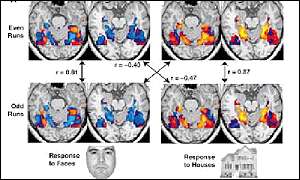| Scientists Can 'read your mind' |

Do you believe that someone can read your thoughts? Well, scientists say they can now tell what you are looking at. Researchers found people's brains showed a particular pattern if they were looking at shoes, a chair, or a cat. In a study, magnetic resonance imaging (MRI) scans showed individuals' brains displayed particular patterns for each object they were shown.

Previous research has shown particular areas in the ventral temporal lobe of the visual cortex in the brain reacted to seeing faces, or houses and places. But this work, by scientists from the National Institute of Mental Health (NIMH) in America, suggests the whole lobe reacts and displays particular patterns. The research is published in the journal Science.
How the brain 'sees'
Dr James Haxby, of the NIMH Laboratory of Brain and Cognition, said the research could help decipher the brain's code for recognising objects and faces. He said: "Brain imaging may be able to show how the brain encodes complex information, such as the appearance of objects, not just where the encoding occurs." He said the discovery of these patterns could represent how objects and faces are "related visually, structurally or semantically". He added those patterns had the "capacity to produce unique representations of a virtually unlimited number of object categories."
The researchers suggest that even though there is a "specialised" region that recognises "places", within that area there are distinct patterns of responses which can be spotted for other objects, including shoes, cats and chairs. They call this "object form topography".
In the study, six people were shown pictures of faces, cats, houses, chairs, scissors, shoes and bottles, plus a nonsense image. Three-dimensional MRI scans were taken, showing how active parts of the brain were. Pairs of responses to different views of the same image, and between categories were compared. Patterns for houses, faces and scrambled pictures were 100% accurate. Even when the areas that reacted most to particular objects were excluded, the patterns were a 94% match.
Potential uses
Dr Russell Epstein, a research scientist at the Medical Research Council Cognition & Brain Sciences Unit in Cambridge, UK, has carried out research that shows the same part of the brain is active when people look at places or houses. He said it was known that even those particular areas that responded to certain categories of images, such as places, also showed activity when other objects were looked at.
"What this has basically done is quantified that kind of information."
Dr Epstein said the US findings showed not all reactions were the same. "When I look at a shoe, it will be different to when you look at a shoe."
Dr Epstein added that a more serious application could be in images of patients who have just suffered a stroke, where doctors may be able to tell if recognition of particular objects has been affected.
|